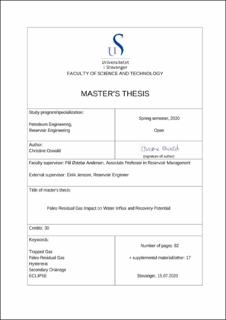| dc.description.abstract | Whereas residual gas has been studied by many researchers, there has been little discussion about paleo residual gas. When encountered in a well, these dead gas columns are usually immobile, and the well is considered dry. However, under changing conditions, the gas can remobilize and contribute to economic recovery. The review of present publications revealed, that paleo gas remobilization during depletion takes place after overcoming a remobilization threshold (ΔSg,remob). Prior studies have noted the importance of applying secondary drainage curves to reliably simulate the remobilization process.
This thesis presents a reservoir simulation study on modelling paleo residual gas expansion and remobilization during pressure depletion in a gas field case using the commonly applied Killough hysteresis model. In the presented field case, paleo residual gas is indicated by a wireline log showing gas columns below measured FWL and an unsuccessful drill stem test of these gas saturations.
The major contribution of this thesis is to provide an assessment of paleo residual gas and its general influence on incremental recovery potential and water influx. Investigating, how paleo residual gas will remobilize subjected to the field-specific prolific layers, i. e. an upper and lower high permeability layer, is a second aim of the study. A field-specific estimate of the incremental recovery potential and impact on water influx is elaborated.
An one-dimensional core model is used to derive reliable saturation functions from experimental data and a two-dimensional conceptual model is used to solve the above mentioned objectives. Different paleo column height (dpaleo) scenarios are tested as well as different initial gas saturations in the paleo column (Sgi,paleo) and different critical gas saturations.
The conclusions of this study are that paleo residual gas columns can be initialized by using imbibition negative Pc and hydrostatic equilibrium option, which is a standard option in commercial simulators.
Paleo gas saturations increase recovery potential during depletion with increasing dpaleo, with increasing Sgi,paleo and decreasing ΔSg,remob. Disregarding ΔSg,remob leads to overestimation of the recovery potential.
Paleo gas saturations increase water production during depletion with increasing dpaleo, with decreasing Sgi,paleo and increasing ΔSg,remob. Disregarding ΔSg,remob leads to underestimation of the water production. The water produced in this model originates from two different regions: from the aquifer and from the paleo gas column due to expulsion by depletion induced gas expansion before remobilization. The influence of the aquifer is dimmed by the presence of paleo residual gas due to water mobility reduction.
Due to the field-specific weak aquifer, the counteracting effect of paleo gas is less significant on reducing water production originating from the aquifer influx. Water production is less related to the aquifer influx but more result of water expulsion due to gas expansion before remobilization. The field-specific high permeability layers cause increased total gas production and increase the risk for earlier water breakthrough. Water breakthrough appears significantly earlier and more pronounced with high permeability layers. | en_US |

